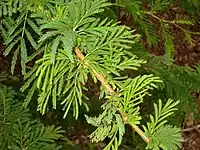mũrera
See also: murera and murerà
Kikuyu
 mũrera |  mũrera |
Etymology
From kũrera (“to float, to hover, to glide”).[1]
Pronunciation
- IPA(key): /mòɾɛ́ɾáꜜ/
- As for Tonal Class, Benson (1964) classifies this term into Class 7 with a disyllabic stem, together with njata, and so on.
- (Kiambu)
- (Limuru) IPA(key): /mòɾɛ̀ːɾǎ/
- As for Tonal Class, as mũreera, Yukawa (1981) classifies this term into a group including gĩkwa (pl. ikwa), ithangũ (pl. mathangũ), kiugũ, kĩboko, kĩgunyũ, kĩnya, kĩroboto, kĩrũũmi, mbogo, mũcinga, mũgate, mũhaka, mũrangi, mũrũthi, ndaraca, ndirica, njohi, nyũmba, thĩ, and so on.[2]
Noun
mũrera class 3 (plural mĩrera)
- fever tree, Naivasha thorn (Acacia xanthophloea)[1][3][4]
See also
- mũgaa, mũthandũkũ
References
- “mũrera” in Benson, T.G. (1964). Kikuyu-English dictionary, p. 379. Oxford: Clarendon Press.
- Yukawa, Yasutoshi (1981). "A Tentative Tonal Analysis of Kikuyu Nouns: A Study of Limuru Dialect." In Journal of Asian and African Studies, No. 22, 75–123.
- Dharani, Najma (2002). Field Guide to Common Trees & Shrubs of East Africa, p. 38. Cape Town: Struik Publishers. Rep. 2005. →ISBN
- Leakey, L. S. B. (1977). The Southern Kikuyu before 1903, v. II, p. i. →ISBN